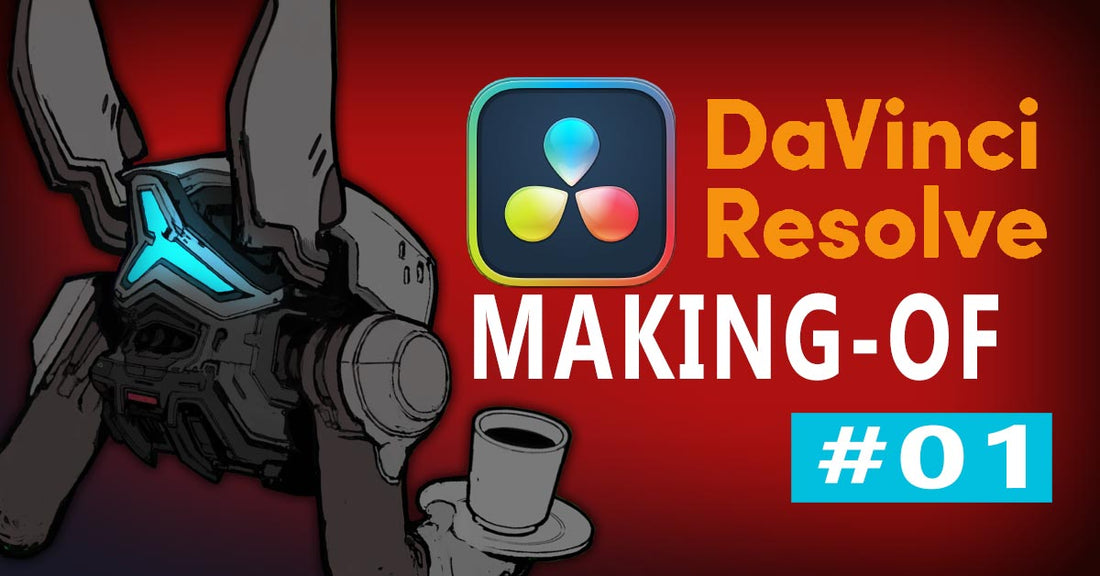
Bytebot Scene Setup – Fusion Workflow Breakdown making-of #01
This scene depicts CaptHec in his downtime, watching Earth’s internet. Bytebot, his assistant, is returning with a cup of coffee he grabbed from the Wuburger—the fast food joint on the second floor of the spaceship
When Time Is Tight: Keep It Simple
I didn’t have much time for this shot, so I went with just two key poses. This is a new version of the Bytebot character — if you've seen my earlier concept video, you’ve already seen how the look evolved. The file is a layered PSD that I’ll bring into Fusion to start building the animation setup.

Importing the PSD into Fusion
Fusion > Import > PSDSwapping the Old Rig for the New One
Next, I’m replacing the old flat Bytebot image in the composition.
- Pressing
1on the keypad helps me quickly preview any node. - I insert a new Merge node where I’ll add the new layered Bytebot version on top of the old one.
- The goal: match the position and scale so I can just swap them seamlessly.
- There are lots of ways to do this, but I prefer this overlay approach so I can visually align the new rig.

Rescaling with a Transform Node
The scale obviously doesn’t match yet, so I:
- Add a Transform node.
- Adjust the scale until the new Bytebot matches the original positioning.
At this stage, you can also tweak blend modes or layering behavior, but for now, I’m keeping it simple.
Quick Node Connector Tip
One thing that often trips people up: green connectors in Fusion = Foreground.
So, anything you connect through the green input will appear on top of what's already in the flow.
In this case, the new layered Bytebot is going over the existing node because it’s plugged into the green connector. Keep that in mind — it helps with organizing your setup visually and functionally.
Naming Your Nodes Clearly
It’s easy to get lost in a big node graph. That’s why I always rename important nodes.In this case, the node controlling Bytebot’s movement is now renamed: Naming nodes makes a huge difference when you revisit your comp days or weeks later — especially for ongoing projects like this webseries.
Why You Need a Background Node
If I delete the original Bytebot image now, everything disappears. That’s because Fusion requires a background in the Merge node to render anything. So, I add an empty Background node, and set its alpha to 0 so it’s fully transparent. Now the new Bytebot layers have a proper base — even without the old image.
What’s Next? Adding Life to the Rig
Right now, Bytebot’s floating stiffly. In the next video, I’ll start animating subtle body tilt and lateral movement — just enough to simulate a bit of flying instability. Nothing fancy, but it helps bring the character to life.

Download the layered Bytebot PSD for free on Gumroad [asset not available yet]
Take Bytebot Beyond the Screen
Here’s a closer look at the latest Bytebot illustration:
This design is now part of the official Signal From Earth collection. You can explore several color variations — plus hoodie versions — right here.
Didn’t find exactly what you’re looking for? Drop us a line at contact@wuli.rocks and we’ll be happy to customize something just for you.
Curious minds also asked:
Want to earn while sharing? Our affiliate program offers 70% revenue on sales of Wulirocks products.
- Sign up here
- Learn more here [page not ready]
Thanks again for stopping by — and feel free to reach out with any questions or ideas!




![Women's Long Sleeve Shirt [I Got The Poison - Skelknight Blue]](https://cdn.shopify.com/s/files/1/0622/2227/0547/files/female_i_got_poison_RoseGold_a0e0c53b-4a5b-4b46-ab22-0f1466b62acd_70x70.jpg?v=1735114683)
